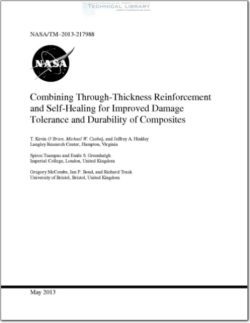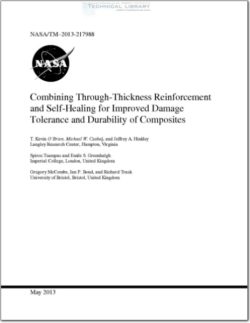NASA-TM-2013-271988

- Version
- 173 Downloads
- 3.14 MB File Size
- 1 File Count
- April 21, 2016 Create Date
- April 21, 2016 Last Updated
Combining Through-Thickness Reinforcement and Self-Healing for Improved Damage Tolerance and Durability of Composites

A well-established scheme for mitigating or suppressing delamination growth in a composite
laminate is to insert carbon Z-pins in the through-thickness direction [1,2]. The apparent
interlaminar fracture toughness of the composite is increased due to the tractions imposed by the
Z-pins as they pull out during delamination growth, thereby providing improved damage
tolerance [3,4]. Other attempts have been made to introduce self-healing resins to the crack plane
as delaminations grow, to restore some of the initial fracture toughness. This may be
accomplished via microencapsulation [5-7] or embedding the resin in hollow glass tubes in the
planes of the fibers [8-10]. Introducing a self-healing resin has the added benefit of sealing the
crack plane to prevent moisture ingression, and hence, improving durability.
A study was undertaken to develop a prototype method for adding through-thickness hollow glass
tubes infused with uncured resin and hardener to a carbon Z-pin through-thickness reinforcement
field. The Z-pins are intended to provide delamination resistance as they pull out during a
delamination event. Simultaneously, the glass tubes will fracture and release the enclosed resin
and catalyst. The tractions provided by the Z-pin pull-out mechanism should allow time for the
resin to cure, and minimize crack opening to reduce the volume that needs to be filled, resulting
in a self-healed fracture plane.
An “initial study” was first undertaken where half the carbon Z-pins were replaced by the hollow
glass tubes in the foam preform prior to insertion in the uncured laminate. Because the survival
rate of the glass tubes was not sufficient, a more detailed “main study” was then conducted where
all of the carbon Z-pins in the preform were inserted into the uncured laminate, and then half
were removed and replaced with hollow glass tubes. This technique resulted in a nearly 100%
survival rate for the hollow glass tubes, allowing resin insertion, followed by testing, to evaluate
the proposed concept.
Z-pin pre-forms consisting of 0.5 mm diameter pultruded carbon fiber tows embedded in a low
density foam were purchased from Albany Engineered Composites. The Z-pins are typically
inserted in an uncured tape laminate using an ultrasonic hammer (fig.1), resulting in a 2% by
weight areal density of through—thickness Z-pins. For this study, half of the Z—pins in the pre-form
were replaced with 0.55 mm outer diameter, 0.4 mm inner diameter, hollow glass tubes.
| File | Action |
|---|---|
| NASA-TM-2013-271988 Combining Through-Thickness Reinforcement and Self-Healing for Improved Damage Tolerance and Durability of Composites.pdf | Download |

Comment On This Post